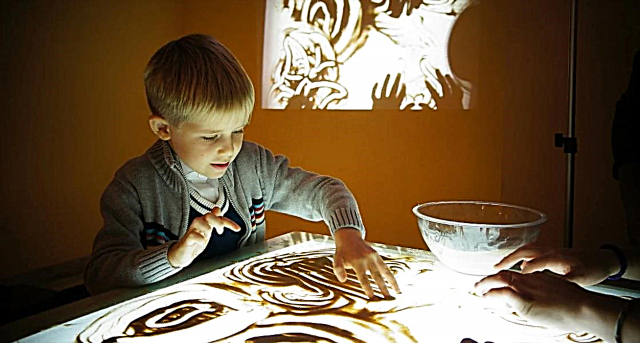
More and more modern specialists are inclined to think that school should not be the only place where a child is taught - in many ways, parents themselves should help the child acquire various skills. Actually, it is much easier for parents to grasp the appropriate mood of the child, and the children themselves are much more inclined to communicate with their loved ones, therefore, in some cases, they are better able to perceive information precisely in home schooling.
Many parents believe that the child should be able to write numbers on his own even before school, and if in kindergarten the baby has not yet been taught this, parents should get down to business themselves. This task is not an easy one, but also not the most difficult if you thoroughly understand it.

How to teach a child on your own?
It should be noted right away that we learn to write numbers only after we confidently master the concept of counting, otherwise the whole process will be greatly slowed down - the child will begin to draw scribbles, which are a perfect abstraction for him. Therefore, it is worthwhile to correctly build the sequence of classes, and start, first of all, with an oral account.

Modern children learn to count quite early - they must become familiar with the concept of numbers no later than 3 years. By this time, special developmental literature manages to acquaint them with the visual designation of numbers, but they will not be fixed in the baby's head until he begins to use them himself. Experts advise in a playful way to ask the child to count certain objects - this must be done every or almost every day.
At this stage, the numbers should be simple - from 0 to 9. It is necessary to closely monitor the child's mood - it is undesirable to "load" him with studies when he clearly does not want to, otherwise it will be much more difficult to achieve success.
That is why classes should resemble a game, and for any success the baby must be praised out loud.

When the child has learned to count consistently (just do not think that a day or at least a week is enough for this!), It is time to consolidate the knowledge of the numbers so that the baby can confidently determine them, not remembering every time in his head what number comes after the four. To do this, you need to connect associative thinking, "tying" each number to a specific place or event.
Relatively speaking, you can draw a large beautiful number (any) in the kitchen, and another - on the front doors, explain to the kid what these numbers are and make them associate with eating or walking. Since the task is to move away from the strict sequence of numbers, they should not describe the schedule of the day in order, but be random. Only when the child learns to confidently identify each written number, you can start learning to write.
Activities with a preschooler
Once upon a time, all the hopes of parents for teaching kids were associated with school, but in the modern world it is easier for a child to learn how to write numbers even before school, especially since there they will already provide a lot of other useful information. Experts recommend starting appropriate training for preschoolers not earlier than at the age of 4-5 years - it is at this stage that they are already ready to normally perceive information of this level of complexity.

A psychological approach is very important here. It should be borne in mind that the child at this stage does not at all understand the whole meaning of having such a skill, and if he does not like the learning process itself, he will not break himself for a great goal, but will simply be capricious and not take information. At the same time, writing numbers for a kid who has not yet learned how to do this is no easier than drawing Chinese characters for parents.
Among other things, he differs from adults also in that he gets tired much faster, so it is fundamentally important to have great patience and in no case scold the child if he fails. In no case should you also force him to sit on the task until he succeeds - He doesn't do bad things on purpose.
It is believed that the optimal duration of a lesson does not exceed 15-20 minutes, but you can shorten it even more in favor of more frequent repetitions - this will give a faster result.
The most reliable explanation for a kid why he should be engaged is because it's interesting. So that the child does not get bored with a monotonous, albeit short-lived lesson, alternate techniques. You can draw numbers along a contour, from point to point, using a special notebook, or even just sketch them from your favorite color book, because children love to draw. It remains only to direct this energy in the right direction, inviting the child to draw something useful for himself.


Help for the student
Now it is already quite difficult to find such a child who, by the time of going to first grade, would still not be able to write numbers. Nevertheless, all sorts of situations happen, and newly-made first-graders usually, if they know how to write numbers, they do it rather clumsily. You can hope that over time the skill will develop on its own, but it is better to remember in time that there are adults with disgusting handwriting, so it is worthwhile to start solving the problem early.

Again, you can learn to write beautifully as a result of constant practice, but the question is whether the child will try, depicting a number, or will be limited to the formal similarity of the doodle.
It has been proven that those children who devoted a lot of time to calligraphic derivation of numbers and letters, over time, learn to write beautifully quickly and without the slightest effort.

Today it is much easier to get a child interested in calligraphy than before, because now a huge number of manuals have been invented that allow you to give learning a playful form. Separately, it is worth highlighting all the same connecting dots - kids are very fond of such tasks, because drawing is not yet subject to them at a sufficient level, and only in this way they can depict something that could be proud of.
There are special notebooks devoted only to spelling, but you can pick up more cunning manuals for your child, where numbers and letters are like characters in a complex picture. Here it is necessary to note a subtle psychological move - a child, once having achieved a nice outline of letters and numbers, may experience some kind of disappointment from the state in which his daily calligraphy is. It was then that you should slip him a specialized study book, hinting that he can always write beautifully this way. Nevertheless, you can't press here either.

How to train a left-handed person?
Contrary to popular belief, teaching a left-hander to write beautifully is no more difficult than a right-hander, because they both learn from scratch. The only difficulty for a left-hander may lie perhaps in the fact that the spelling of numbers was invented by right-handers, therefore it is a little more "sharpened" for the needs of the right hand, not the left. Nevertheless, there is still not a single known case when one of the teachers came up with the idea of drawing separate educational notebooks and dot pictures especially for left-handers - they study using the same teaching aids and methods as all other children.


By the way, many parents notice that their children in the process of learning how to write numbers depict them in a mirror image, which is often perceived as a sign that the child is left-handed, even if he writes with his right hand.
Specialists in child development argue that the nature of this phenomenon is somewhat different - the child's brain is simply not yet sufficiently developed to fully perceive spatial phenomena, therefore, the child, having memorized the outline in general, is not always able to keep the angle of rotation of the number in his head. With a frequent demonstration of such an effect in a child of 4-5 years old, it is usually recommended to simply postpone the training of calligraphy until a later date - the child, apparently, is not yet ready.
If the situation is typical for an older baby, you need to contact, oddly enough, a speech therapist.


Best practices
There are quite a few different techniques designed to present the process of learning numbers as something very interesting for a child. Several of them are used by the popular author of children's educational literature in his special notebook to teach how to write numbers. Elena Bortnikova.
For a child, the easiest way to write a number more or less believable is to circle it along a previously sketched contour. This is exactly what the author proposes to do for the kid, simultaneously adding an element of the game and simple counting, because not only the figure itself will have to be circled, but also the corresponding number of objects - waves, mushrooms, and so on. Some problems contain small examples, such as "4 + 1 = 5", which is also illustrated in the figures.
At the same time, everything looks rather monotonous and does not look so much like a game, therefore the time devoted to study will indeed have to be measured.


The notebook also assumes that in a real school, the child will have to write not by dots, but by cells, and neatly - so that the numbers do not get out of the box. Without a specially developed skill, this is not so easy to do, therefore there is also a section in the notebook devoted to the guidance of a dotted contour inscribed in a cell. It is hard to judge how effective this technique is, but the child will get some idea of what awaits him in the future.


Some experts, by the way, believe that there is no need to rush to teach writing in general - it is better to carefully prepare the child for the moment when he will be taught this at school. Such training does not provide for writing classes, but it allows you to tremendously develop fine motor skills, which will help you learn new skills as quickly as possible.
Absolutely any way to develop finger skills will work here: a finger twister and shadow theater, making applications and cutting out figures from paper, drawings in the sand and folding origami, working with a designer and weaving, modeling from plasticine and drawing.
It is difficult for a child to write an ordinary letter "a" in the same way as for a person who cannot draw it is plausible to draw "Mona Lisa", because he is not yet very good at using his hands, therefore, you need to help him at least in this.

We parse the numbers in detail
We, adults, write numbers without thinking at all about the writing mechanism, and the child still needs to clearly explain how to do this in the most convenient way. Special visual "instructions" are published, including single-digit numbers, including zero, as well as large composite numbers like fourteen, and signs "less" and "more" - for a parallel minimal mastery of mathematics.
In general, the process can be explained to the child as follows:
- 0 - is a simple oval, occupying only the right half of the cell, its upper part is inclined to the right; is drawn in one circular motion.
- 1 - from the center of the cell we draw a line to the upper right corner, and from there - another one, to the middle of the lower line of the cell.


- 2 - from the center of the upper half of the cell, we begin to draw a semi-oval to the right, touching first the upper and then the right edge (at the same height from where we started), then from the same point we draw an oblique line to the center of the lower edge. After that, from the center of the bottom line to its right edge, draw three waves - up, down, and up again.
- 3 - it is easiest for a child to explain the diagram as "we draw a snowman from two balls open on the left, the top of which is a little smaller" on the right side of the snowman's cell.


- 4 - from the center of the upper edge, we begin to draw a line downward with a slight slope to the left, in the middle of the height we turn it horizontally to the right, slightly before reaching the right edge, we tear off the handle. Finish "four" with a slanting line from the upper right corner to the middle of the lower edge.
- 5 - slightly to the right of the central axis of the cell, draw a line from top to bottom to the middle of the height, which gradually shifts to the left, and then from its end we draw an oval that is not closed on the left side, touching the right and lower ribs. We tear off the hand and separately draw the "bird" at the top.


- 6 - from the upper right corner up and to the left, we begin to draw an oval with the expectation of covering the right half of the cell, touching the upper and lower edges, but after that we sharply turn the lower part into a circle touching the right edge and connecting with the previously drawn line practically in the center of the cell.
- 7 - in the right half of the upper part of the cell, from the middle to the corner, draw a wavy line, and then, without lifting our hands, from the upper right corner we continue it to the center of the lower edge. We tear off the hand and cross the last straight line in half with a short line.


- 8 - again "snowman": we draw in one motion, starting in the middle of the future upper oval (smaller), without closing it, go to the lower oval, and having finished drawing it, close the upper one at the point from which we started.
- 9 - draw a circle for the entire upper right corner, starting from the point of contact with the right edge, draw its line through the upper edge and center of the cell, and returning to the starting point, "unfold" and draw the unfinished oval so that its base is shifted to the left and touched the lower rib.


Writing more complex numbers like 10, 14 or 20 will not be difficult for a child, because they are not written together - it is only important that he understands their composite essence and principles of compilation.

Consolidation of the studied material
There is no better way to consolidate knowledge than practice, therefore, upon completion of the study of theory, it is necessary for the child to work quite a lot in writing. remember, that writing is a difficult task, the child gets tired quickly, so you shouldn't "load" him to exhaustion. A preschooler needs to learn how to write numbers for no more than 20 minutes a day, regardless of the success of the results.


For how to teach a child to write numbers, see the next video.



